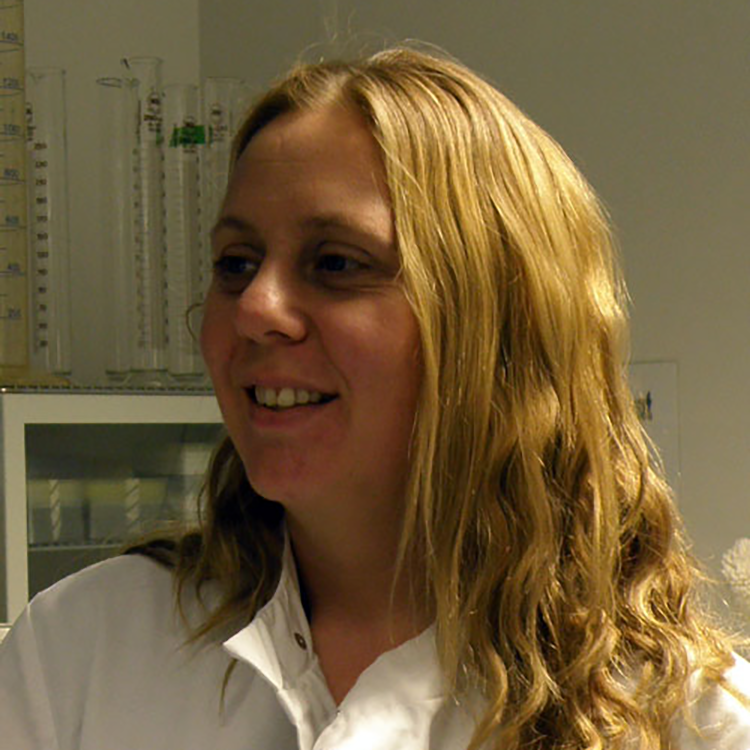
"The next big step in for microbial ecology is to work out what this huge diversity of microbes within the marine environment are actually doing. At PML, I am embedded within a network of biogeochemists, physical oceanographers and ecosystem modellers to aid me untangling these mysteries."
Following on from a PhD in biofilm ecology at Edinburgh University, Karen Tait embarked on her first post doc at PML. In ground-breaking research, Karen was able to demonstrate a link between the settlement of the reproductive stages of both the green seaweed Ulva and the acorn barnacle Balanus improvises and signal molecules produced by bacterial biofilms. Twenty years on, Karen continues to study the complex interactions within marine and occasionally freshwater ecosystems, and uses molecular biology tools (qPCR, next generation sequencing, bioinformatics) to untangle the links between microbial community structure and diversity and biogeochemical cycling within temperate and polar coastal and shelf sea ecosystems This includes study of the interactions between bioturbating macrofauna, microbially-driven nutrient cycling and nutrient regeneration.
- BIO-PLASTIC-RISK: Biodegradable plastics - assessing environmental risk; NERC (2021 – 2025)
- MARINe-DNA: Development and application of eDNA tools to assess the structure and function of coastal sea ecosystems; NERC (2016 – 2020).
- Shelf Sea Biogeochemistry: Biogeochemistry, macronutrient and carbon cycling in the benthic layer; NERC (2013 – 2017).
- Joint I*, Tait K*, Callow ME, Callow JA, Milton DL, Williams P. and Cámara M. (2002) Cell-to-cell communication across the procaryote-eucaryote boundary. Science, 298, 1207. *These authors contributed equally to this work.
- Tait K, Havenhand H (2013) Investigating a possible role for the bacterial signal molecules N-acylhomoserine lactones in Balanus improvisus cyprid settlement. Molecular Ecology 22:2588-2602.
- Laverock B, Smith CJ, Tait K, Osborn AM, Widdicombe S, & Gilbert, J. A. (2010). Bioturbating shrimp alter the structure and diversity of bacterial communities in coastal marine sediments. The ISME journal, 4(12), 1531-1544.
- Tait K, Stahl H, Taylor P, Widdicombe S. (2015) Rapid response of the active microbial community to CO2 exposure from a controlled sub-seabed CO2 leak in Ardmucknish Bay (Oban, Scotland) IJGGC 38: 171-181.
- V Kitidis, K Tait, J Nunes, I Brown, EMS Woodward, C Harris, AJM Sabadel, DB Sivyer, B Silburn, S Kröger (2017) Seasonal benthic nitrogen cycling in a temperate shelf sea: the Celtic Sea. Biogeochemistry 135: 103.
- Tait K, Airs RL, Widdicombe CE, Tarran GA, Jones MR, Widdicombe S. (2015) Dynamic responses of the benthic bacterial community at the Western English Channel observatory site L4 are driven by deposition of fresh phytodetritus. Progress in Oceanography.
Recent publications
- McEvoy, AJ; Atkinson, A; Airs, RL; Brittain, R; Brown, IJ; Fileman, ES; Findlay, HS; McNeill, CL; Ostle, C; Smyth, TJ; Somerfield, PJ; Tait, K; Tarran, GA; Thomas, S; Widdicombe, CE; Woodward, EMS; Beesley, A; Conway, DVP; Fishwick, J; Haines, H; Harris, C; Harris, RP; Helaouët, P; Johns, DG; Lindeque, PK; Mesher, T; McQuatters-Gollop, A; Nunes, J; Perry, F.; Queiros, AM; Rees, AP; Ruhl, S; Sims, DW; Torres, R; Widdicombe, S; 2023. The Western Channel Observatory: a century of physical, chemical and biological data compiled from pelagic and benthic habitats in the western English Channel. Earth System Science Data.
- Queiros, AM; Tait, K; Clark, JR; Bedington, M; Pascoe, CK; Torres, R; Somerfield, PJ; Smale, DA; 2022. Identifying and protecting macroalgae detritus sinks toward climate change mitigation. Ecological Applications.
- Bolaños, LM; Tait, K; Somerfield, PJ; Parsons, RJ; Giovannoni, SJ; Smyth, TJ; Temperton, B; 2022. Influence of short and long term processes on SAR11 communities in open ocean and coastal systems. ISME Communications.
- Marz, C; Freitas, FS; Faust, JC; Godbold, JA; Henley, SF; Tessin, AC; Abbott, GD; Airs, RL; Arndt, S; Barnes, DKA; Grange, LJ; Gray, ND; Head, IM; Hendry, KR; Hilton, RG; Reed, AJ; Ruhl, S; Solan, M; Souster, TA; Stevenson, MA; Tait, K; Ward, J; Widdicombe, S; 2021. Biogeochemical consequences of a changing Arctic shelf seafloor ecosystem. Ambio.
- Marz, C; Freitas, FS; Faust, JC; Godbold, JA; Henley, SF; Tessin, AC; Abbott, GD; Airs, RL; Arndt, S; Barnes, DKA; Grange, LJ; Gray, ND; Head, IM; Hendry, KR; Hilton, RG; Reed, AJ; Ruhl, S; Solan, M; Souster, TA; Stevenson, MA; Tait, K; Ward, J; Widdicombe, S; 2021. Biogeochemical consequences of a changing Arctic shelf seafloor ecosystem. Ambio.